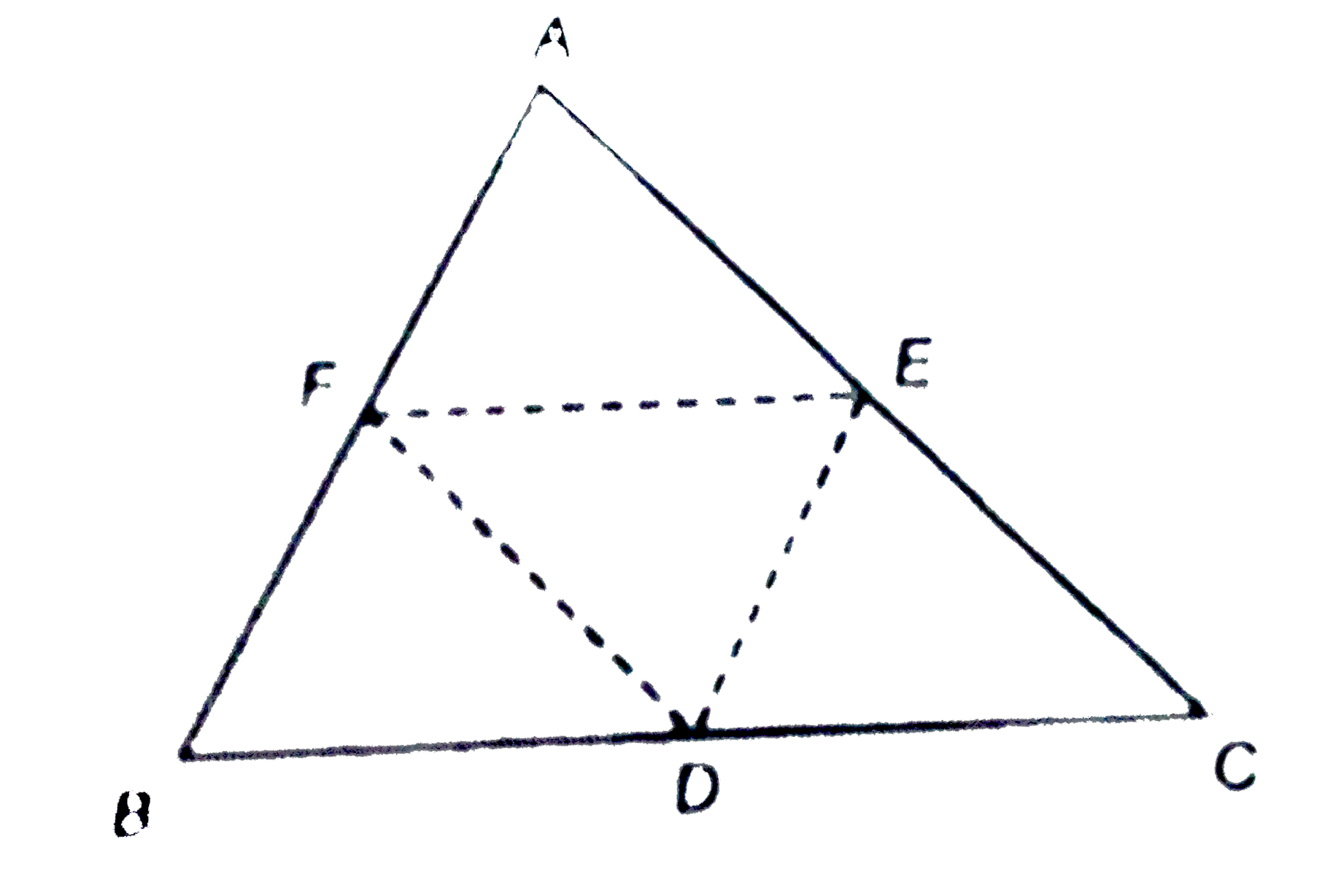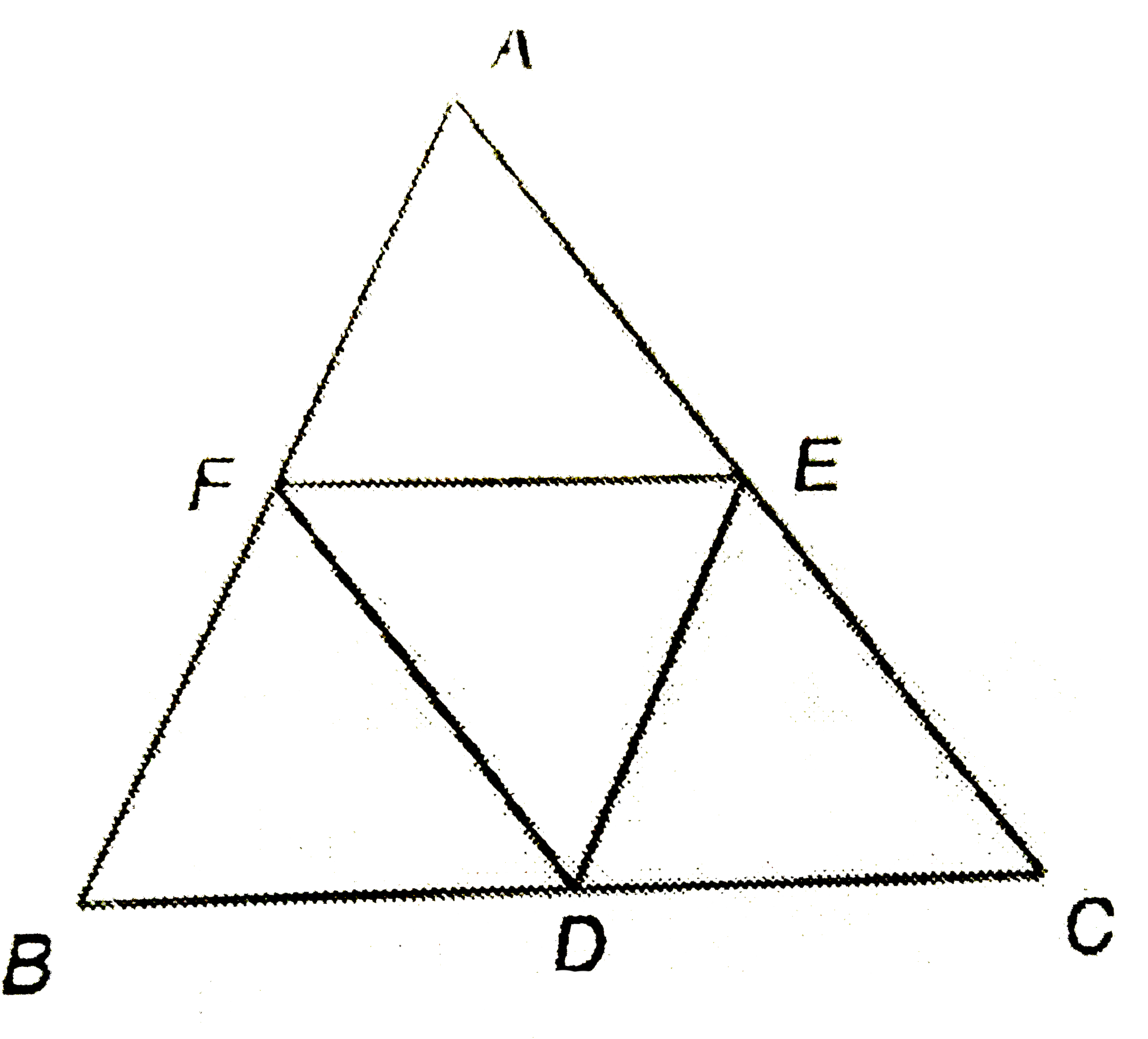D, E and F are the mid-points of the sides BC, CA and AB respectively of triangle ABC. Prove that:
area of BDEF is half the area of
To prove that the area of quadrilateral BDEF is half the area of triangle ABC, we will follow these steps:
Step 1: Identify the midpoints
Let D, E, and F be the midpoints of sides BC, CA, and AB of triangle ABC, respectively.
Step 2: Draw the triangle and midpoints
Draw triangle ABC and mark the midpoints D, E, and F. Connect these midpoints to form quadrilateral BDEF.
Step 3: Draw the diagonals
Join BE and DF. This creates two triangles: triangle AEF and triangle BDF.
Step 4: Use the property of medians
Since D is the midpoint of BC, EF is a median of triangle ABE. By the property of medians, triangle AEF is equal in area to triangle BEF.
Step 5: Establish area relationships
Thus, we have:
- Area of triangle AEF = Area of triangle BEF
Similarly, since E is the midpoint of AC, DE is also a median of triangle BEC. Therefore, we have:
- Area of triangle BDE = Area of triangle DEC
Step 6: Sum the areas
Now, the area of triangle ABC can be expressed as the sum of the areas of the four triangles:
- Area of triangle ABC = Area of triangle AEF + Area of triangle BEF + Area of triangle BDE + Area of triangle DEC
Step 7: Substitute equal areas
Substituting the equal areas from the previous steps:
- Area of triangle ABC = Area of triangle BEF + Area of triangle BEF + Area of triangle BDE + Area of triangle BDE
- Area of triangle ABC = 2 * Area of triangle BEF + 2 * Area of triangle BDE
Step 8: Factor out the common term
Factoring out the common terms gives:
- Area of triangle ABC = 2 * (Area of triangle BEF + Area of triangle BDE)
Step 9: Define area of quadrilateral BDEF
Let’s denote the area of quadrilateral BDEF as:
- Area of quadrilateral BDEF = Area of triangle BEF + Area of triangle BDE
Step 10: Conclude the proof
From the previous step, we can substitute:
- Area of triangle ABC = 2 * Area of quadrilateral BDEF
Thus, we can conclude:
- Area of quadrilateral BDEF = 1/2 * Area of triangle ABC
Final Statement
Therefore, we have proved that the area of quadrilateral BDEF is half the area of triangle ABC.
---
Let D, E, and F be the midpoints of sides BC, CA, and AB of triangle ABC, respectively.
Draw triangle ABC and mark the midpoints D, E, and F. Connect these midpoints to form quadrilateral BDEF.
Join BE and DF. This creates two triangles: triangle AEF and triangle BDF.
Since D is the midpoint of BC, EF is a median of triangle ABE. By the property of medians, triangle AEF is equal in area to triangle BEF.
Thus, we have:
- Area of triangle AEF = Area of triangle BEF
- Area of triangle BDE = Area of triangle DEC
Now, the area of triangle ABC can be expressed as the sum of the areas of the four triangles:
- Area of triangle ABC = Area of triangle AEF + Area of triangle BEF + Area of triangle BDE + Area of triangle DEC
Substituting the equal areas from the previous steps:
- Area of triangle ABC = Area of triangle BEF + Area of triangle BEF + Area of triangle BDE + Area of triangle BDE
- Area of triangle ABC = 2 * Area of triangle BEF + 2 * Area of triangle BDE
Factoring out the common terms gives:
- Area of triangle ABC = 2 * (Area of triangle BEF + Area of triangle BDE)
Let’s denote the area of quadrilateral BDEF as:
- Area of quadrilateral BDEF = Area of triangle BEF + Area of triangle BDE
From the previous step, we can substitute:
- Area of triangle ABC = 2 * Area of quadrilateral BDEF
- Area of quadrilateral BDEF = 1/2 * Area of triangle ABC
Therefore, we have proved that the area of quadrilateral BDEF is half the area of triangle ABC.
Topper's Solved these Questions
- CHAPTERWISE REVISION (STAGE 1) Book:ICSEChapter:CHAPTERWISE REVISION (STAGE 1) Exercise:Circle
Explore 6 Videos
- CHAPTERWISE REVISION (STAGE 1) Book:ICSEChapter:CHAPTERWISE REVISION (STAGE 1) Exercise:Statistics
Explore 9 Videos
- CHAPTERWISE REVISION (STAGE 1) Book:ICSEChapter:CHAPTERWISE REVISION (STAGE 1) Exercise:Rectillinear figures
Explore 24 Videos
- CHAPTER REVISION (STAGE 2) Book:ICSEChapter:CHAPTER REVISION (STAGE 2) Exercise:DISTANCE FORMULA
Explore 12 Videos
- CHAPTERWISE REVISION (STAGE 3) Book:ICSEChapter:CHAPTERWISE REVISION (STAGE 3) Exercise:DISTANCE FORMULA
Explore 11 Videos
Similar Questions
D, E and F are the mid-points of the sides BC, CA and AB respectively of triangle ABC. Prove that:
BDEF is a parallelogram.
View SolutionIn the adjoining figure D, E and F are the mid-points of the sides BC, CA and AB respectively of ΔABC. Prove that:
(i) □BDEF is a parallelogram
(ii) area of ΔDEF=14× area of ΔABC
(iii) □BDEF=12× area of ΔABC

View SolutionD, E and F are the mid-points of the sides BC, CA and AB, respectively of an equilateral ΔABC. Show that ΔDEF is also an equilateral triangle.
View SolutionD,E and F are the middle points of the sides of the triangle ABC, then
View SolutionIn the adjoining figure D, E and F are the mid-points of the sides BC, CA and AB of the equilateral ΔABC. Prove that ΔDEF is also an equilateral triangle.

View SolutionIn a ΔABC,D,EandF are the mid-point of sides BC, CA and AB respectively. If area of ΔABC=16cm2, find the area of trapezium FBCE
View SolutionD, E and F are the mid-points of the sides BC, CA and AB respectively of ΔABC and G is the centroid of the triangle, then −−→GD+−−→GE+−−→GF=
View SolutionIf D,E and F are the mid-points of the sides BC, CA and AB respectively of a triangle ABC and λ is scalar, such that −−→AD+23−−→BE+13−−→CF=λ−−→AC, then λ is equal to
View SolutionIf D,E and F are the mid-points of the sides BC,CA and AB respectively of the ΔABC and O be any point, then prove that OA+OB+OC=OD+OE+OF
View SolutionD, E and F are the mid-points of the sides AB, BC and CA of an isosceles triangle ABC in which AB = BC. Prove that ΔDEF is also isosceles.
View Solution